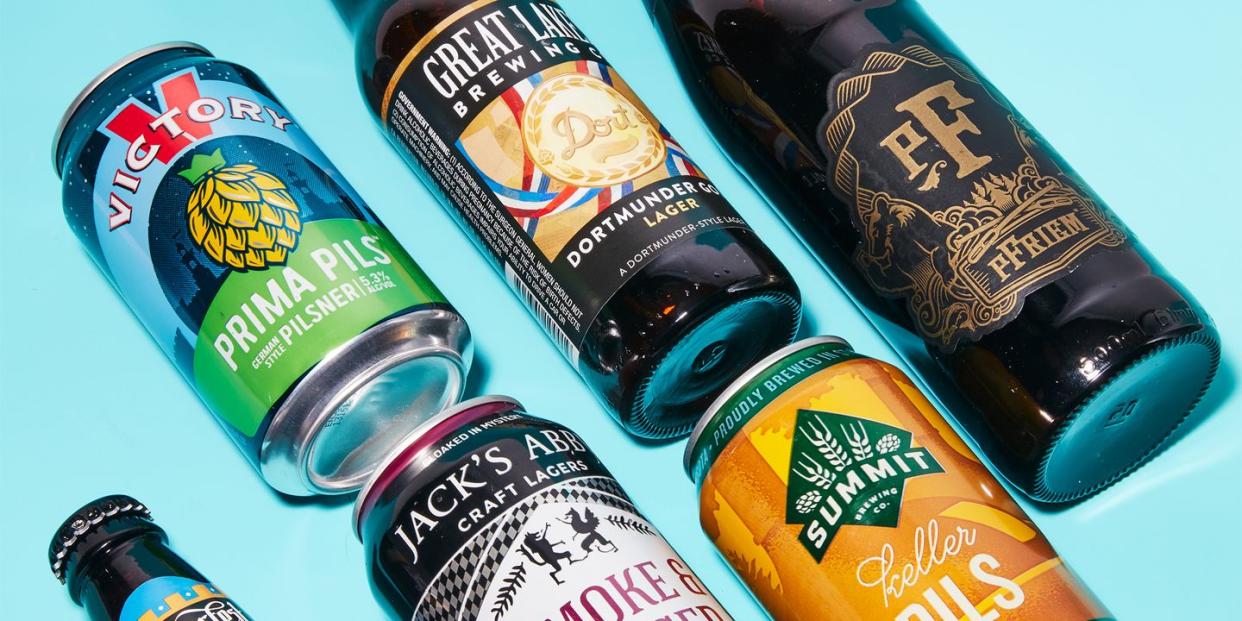Why Your Brewer's Favorite Beer Is a Lager

Walk into a brewery taproom today and it’s no surprise the menu is littered with IPAs. The hop bombs keep the lights on. But look to the corner of the beer list and you’ll likely see a humble lager. Order it. It’s the most carefully brewed beer on tap. While loud and bold IPAs are brewed for the consumer, subtle and highly drinkable lagers are brewed for the brewer.
All beers in this great sudsy world trickle down from two streams: ales and lagers. Craft breweries mostly mess around with ales. Meanwhile, lagers—by far the favored type of beer in the non-craft world—are mainly turned out by megabrewers.
The defining difference between these two families of beer is yeast. Ale yeast ferments faster, at warmer temperatures, and adds more flavor. Lager yeast is slower, enjoys the cold, and instead of adding fruity or spicy flavors, provides a blank canvas for the hops and barley to shine.
“Lager yeast ferments around 50 degrees Fahrenheit; that’s very cold for a microbe,” says Chris White, who holds a Ph.D. in biochemistry and founded White Labs, a brewing yeast supplier. The colder process is better at suppressing unwanted yeast flavors, White says. “The yeast will make apple and banana flavors if it gets too warm.”
But it also means the yeast needs more time to process and remove unwanted byproducts of brewing, like diacetyl, which leaves the unappetizing taste of popcorn butter. Because of that cool environment, fermentation and conditioning typically take at least four weeks (about twice that of an ale). Which is why it’s ironic that your typical beer snob ignores the lager—it’s trickier and takes longer to make, despite its cheap beer reputation.
Due to a lager’s empty canvas, these beers take more technical skill to brew. If anything goes wrong with a lager, you’re going to taste it, White says.
“Ale yeast is more forgiving.” So while German Oktoberfest and hoppy pilsners are delicious examples of lager yeast, that watery Natural Light is still technically impressive for its lack of any flavors—good or bad.
The exact origin of lager yeast is a bit difficult to pin down. It emerged from brewers in southern Germany’s Bavaria, who used cool caves to age and ferment beer, White says. The yeast they relied on formed as a hybrid strain parented by ale yeast and a cold-tolerant wild yeast that’s native to mountainous regions (cross-continental trade likely brought the yeasts together). By the mid-nineteenth century, microbiology and brewing had advanced to the point of scientists isolating lager yeast cells. That allowed laboratories—the precursor to White’s operation—to create and sell pure yeast cultures for brewing.
Those clean cultures, along with refrigeration, spread lagers across the globe, but the longer brew time remains a huge deterrent for most craft brewers and is the reason you usually don’t see more than one lager at a taproom. Of the 7,000-plus operations in America, there are only a handful of lager-focused brewers.
Jack’s Abby cofounder and brewmaster, Jack Hendler, jokes that his lager-only Massachusetts brewery exists due to his naïveté. “We saw an opening in the market for craft lagers, but it takes twice as much equipment.” Hendler says he could double his annual output if Jack’s Abby ever switched to faster-fermenting ales.
Another downside: Because of the lager’s association with cheap beer, customers expect Jack’s Abby to charge less for what is actually a more expensive brew.
But it’s worth it, he says. Because for all the hype that haze and hops get, the lager is where a brewer can really shine. And it’s the beer they are most likely sipping at the end of the day.
This article appeared in the October 2019 issue of Popular Mechanics. You can subscribe here.
You Might Also Like

